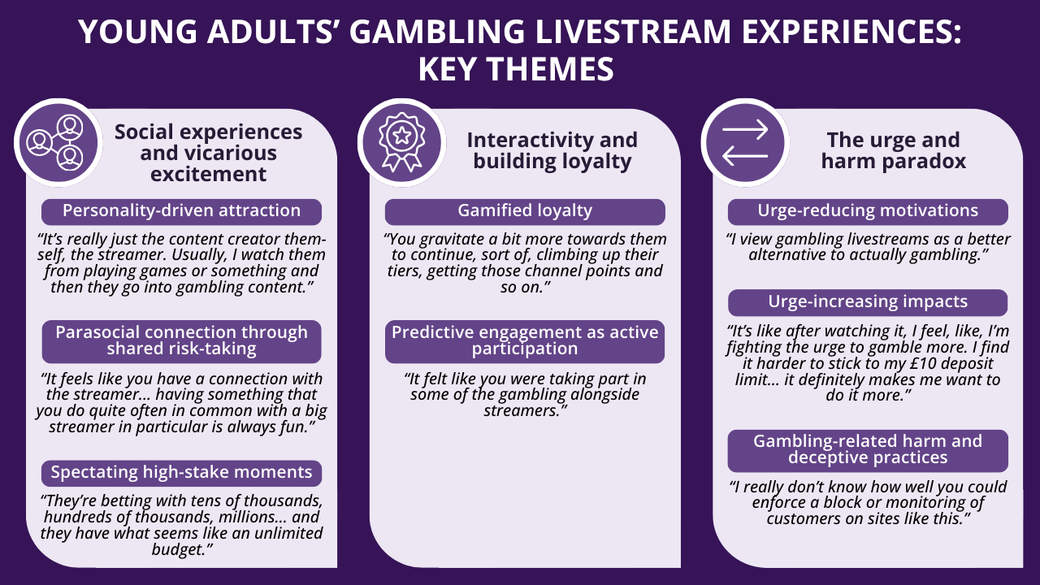The WAGER, Vol. 30(12) – Going live: Young adults’ experiences with and perceptions of gambling livestreams
Livestreaming is a popular form of digital entertainment that allows viewers to watch content online as it happens live. Gambling livestreams are popular on platforms like Twitch and TikTok Live, where streamers broadcast themselves gambling with real money and in real time—playing games like online slots or placing sports bets. Audiences can watch the gameplay, listen to the streamer’s commentary, and interact directly with both the streamer and other viewers. What may seem like harmless fun could be problematic for some, with research linking gambling livestream viewership to future gambling intentions and problem gambling. This week, as part of our Special Series on Addiction and Technology, The WAGER reviews a study by Chelsea Hughes and colleagues that examined young adults’ experiences with and perceptions of gambling livestreaming.
What were the research questions?
(1) What motivates young adults to watch and engage with gambling livestreams? (2) How do they perceive their livestream viewing experiences?
What did the researchers do?
The researchers conducted semi-structured interviews with 15 young adults (ages 18 to 24) in the U.K. who regularly watched gambling livestreams (at least once a week) and had gambled in the past year. Participants described their reasons for watching, how they engaged with the livestreams, and their experiences as a viewer. Using thematic analysis, the researchers identified themes related to the meaning and value viewers attributed to their experiences.
What did they find?
The researchers identified three themes (see Figure).
- Social experiences and vicarious excitement describes the parasocial bonds viewers formed with streamers. Even as observers, viewers felt they were sharing in the streamer’s risk-taking and excitement, which created a sense of emotional connection. Many watched not only for gambling content but because they enjoyed the streamer’s personality.
- Interactivity and building loyalty highlights how livestream features—like gamified loyalty (earning points for engaging with the stream) and interactive prediction tools (wagering points on outcomes)—encouraged viewers to participate and feel more invested in the livestream’s outcomes.
- The urge and harm paradox reflects how participants viewed livestreams as a safer way to manage gambling urges, even though watching sometimes intensified those same urges. Some reported that watching livestreams contributed to an increase in their own gambling participation, despite recognizing the influence of streamers’ deceptive marketing tactics.

Figure. Key themes from young adults’ gambling livestream viewership, with quotes highlighting each subtheme. Click image to enlarge.
Why do these findings matter?
These findings show that young adults are drawn to gambling livestreams for various, often intertwined, reasons. Many viewers feel a personal connection to their favorite streamers. This sense of social connection and community is enhanced by interactive, gamified livestream features that encourage viewer engagement. These findings can inform regulatory policies intended to reduce potential harms. For example, streaming platforms might limit or ban gambling livestreams, or restrict gambling operators from advertising through streamers. The study also indicates that watching these streams is not a reliable way to manage gambling urges, and that for some viewers it may actually worsen cravings. Gambling treatment providers should be aware of gambling livestreams and factor the effects of watching and engaging in these streams into return-to-gambling prevention planning.
Every study has limitations. What are the limitations in this study?
More than half of the sample gambled frequently (20+ times in the past month) and were high-risk gamblers according to the Problem Gambling Severity Index. Therefore, these findings may not be generalizable to low-frequency or low-risk gamblers, or to contexts outside the U.K. where streaming culture, gambling culture, and regulations might differ. Finally, the study cannot determine the causal relationship between livestream viewership and gambling behavior.
For more information:
Individuals who are concerned about their or someone else’s gambling may benefit from visiting the National Council on Problem Gambling or Gamblers Anonymous. For additional resources, including gambling and self-help tools, visit our Addiction Resources page.
— Kira Landauer, MPH
Want CE credit for reading BASIS articles? Click here to visit our Courses Website and access our free online courses.